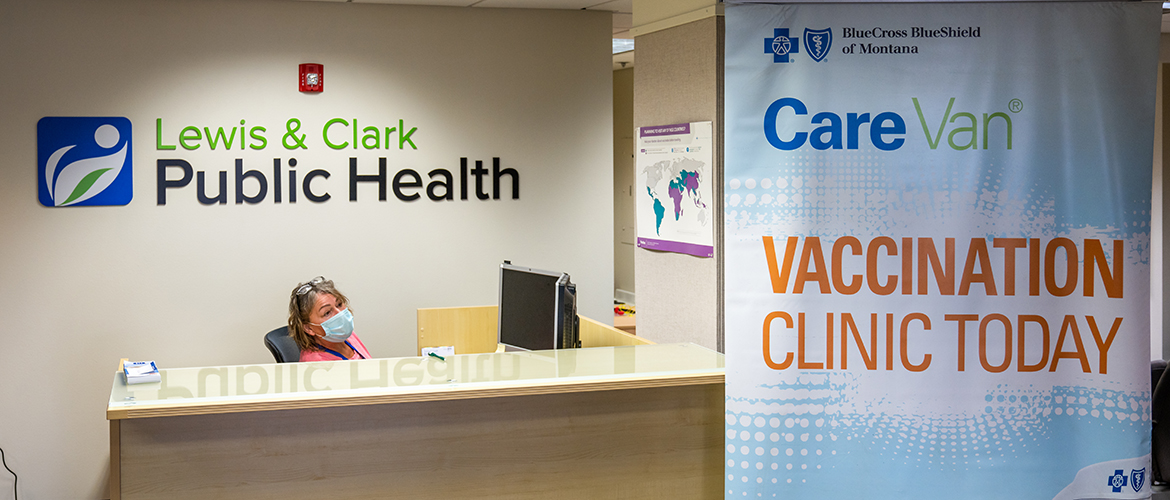Immunizing children and infants became Shelly Maag’s priority after her Helena clinic transitioned to an appointment-only schedule to limit exposure to the novel coronavirus.
Before the outbreak, parents could walk in the Lewis & Clark Public Health clinic three days a week to get their children vaccinated. Now, the clinic requires health screenings and temperature checks before children and parents are led to a vaccination area which is cleaned and disinfected after each appointment.
“We haven’t been giving as many vaccines as we normally do,” says Maag, a public health nurse over communicable disease prevention and immunizations. “It’s been a challenge.”
Plunging vaccination rates caused by COVID-19 infection concerns have complicated the traditional ways community organizations, providers and public health departments push immunizations ahead of the school year. Large-scale immunization and back-to-school events have been replaced by appointment-only and drive-through vaccination clinics to ensure safety, while protecting children from potentially dangerous diseases other than COVID-19.
“Keeping up with vaccines is paramount to prevent one crisis from causing another,” says Dr. Stephanie Vomvouras, vice president and chief medical officer of quality and accreditation for Blue Cross and Blue Shield Plans in Illinois, Montana, New Mexico, Oklahoma and Texas. “It could lead to an epidemic on top of a pandemic.”
“Keeping up with vaccines is paramount to prevent one crisis from causing another."
Maag is vaccinating as many children as she can despite challenges the coronavirus presents.
“There’s a good chance parents wouldn’t get their children vaccinated if we didn’t prioritize vaccinations for back-to-school and young kiddos,” says Maag, whose clinic’s immunization program is one of a few supported by the Caring Foundation of MontanaSM and its Care Van® program. “We love the Care Van program because it helps families who have no insurance get vaccinated. It really decreases the stress for these families and improves immunization rates.”
The program, sponsored by Blue Cross and Blue Shield of Montana, provided more than 5,950 vaccinations in 2019 and over 22,000 free or reduced-cost vaccinations since 2014. BCBSMT in 2018 launched its nonprofit Caring Foundation to improve vaccination rates and offer other health services to rural and underserved Montana populations.
Although Care Vans were taken off the road because of the pandemic, the program has been providing financial support and supplies to community partners to help them get kids immunized.
“Ensuring that immunization rates stay up during the pandemic has been a priority for not only the Care Van, but our partners across the state,” says Kamille Kirchberg, Care Van program coordinator.
After the vans return to the road, program partners may choose to continue requiring appointments, says Kirchberg, adding that outdoor clinics will be held when possible. Indoor space that allows for social distancing also may be used, or people may be asked to wait in their vehicles until they can safely enter the Care Van, which will be cleaned after each patient.
Immunizations drop worldwide
Health care experts are concerned a drop in vaccinations rates could cause other disease outbreaks.
After the pandemic declaration in March, office visits for immunizations among Blue Cross and Blue Shield of Montana members declined, dropping nearly 39% between March and May compared with the number of visits reported during the same period in 2019.
Parents nationwide have canceled pediatric checkups, and immunization levels for vaccine-preventable diseases have plummeted, according to the National Foundation for Infectious Diseases. Well-child office visits have decreased 50%, and doses distributed through the federally funded Vaccines for Children program have dropped significantly.
The World Health Organization (WHO) and UNICEF have reported a decline in the number of children receiving life-saving vaccines around the world.
“Vaccines are one of the most powerful tools in the history of public health, and more children are now being immunized than ever before,” says Dr. Tedros Adhanom Ghebreyesus, WHO director-general. “But the pandemic has put those gains at risk. The avoidable suffering and death caused by children missing out on routine immunizations could be far greater than COVID-19 itself.”
Recognizing the urgency, the five Blues Plans are developing tools and pilot programs that eventually could help its medical directors identify opportunities to increase member immunization rates. Data scientists from the their Quality Innovation Institute have developed a county-by-county mapping tool, breaking down numbers, including membership, plan types and primary care physician selections, as well as vaccination rates and demographic information.
“This (mapping) tool will help us find opportunities to implement initiatives,” says senior data analysis director Dimitrina Dimitrova.
The company's health innovation platform incubator team is launching a pilot that will focus on pregnant women and mothers of infants and children up to age two. The team will test immunization approaches with these families to develop methods that meet their needs.
Flu season preparations
As flu season approaches, Maag is considering ways to safely vaccinate as many people as she can. Indoor clinics may be out of the question because they quickly fill and become tightly packed with staff and patients.
Possible alternatives include drive-through test tents where social distancing will be manageable.
“We’re going to have to be creative,” Maag says. “Flu shots are going to be done differently this year.”

